Configurazioni messianiche in “Die Juden Von Zirndorf” (“Gli ebrei di Zinrndorf”) di Jakob Wassermann
Abstract
Gli ebrei di Zirndorf (1897) di Jakob Wassermann, un ambizioso affresco della società ebraico-tedesca fin de siècle, presenta diverse declinazioni e nozioni di messianesimo, non interamente riconducibili alla tradizione ebraica. Il testo si confronta in particolare con le figure di Šabbetay Şevi e Gesù, servendosene per scandagliare la spinosa dinamica di appartenenza ed esclusione caratteristica della condizione ebraica in Germania. Ciò è evidente soprattutto in Agathon, il protagonista del romanzo, che assurge a Messia di una nuova religione sensuale e terrena. Il presente contributo approfondisce la questione del messianesimo alla luce degli sviluppi della Wissenschaft des Judentums e del saggio di Lou Andreas Salomé Jesu der Jude.
Downloads
SigMa pubblica in internet, ad accesso aperto, con licenza:
|
|
CCPL Creative Commons Attribuzione |
L'autore conserva il copyright sul suo contributo, consentendo tuttavia a chiunque "di riprodurre, distribuire, comunicare al pubblico, esporre in pubblico, rappresentare, eseguire e recitare l'opera", purché siano correttamente citati l'autore e il titolo della rivista. L’autore, al momento della proposta di pubblicazione, è inoltre tenuto a dichiarare che il contenuto e l’organizzazione dell’opera è originale e non compromette in alcun modo i diritti di terzi, né gli obblighi connessi alla salvaguardia di diritti morali ed economici di altri autori o di altri aventi diritto, sia per testi, immagini, foto, tabelle, sia per altre parti di cui il contributo può essere composto. L’autore dichiara altresì di essere a conoscenza delle sanzioni previste dal codice penale e dalle leggi speciali per l’ipotesi di falsità in atti ed uso di atti falsi, e che pertanto Reti Medievali è esente da qualsiasi responsabilità di qualsivoglia natura, civile, amministrativa o penale, e sarà dall'autore tenuta indenne da qualsiasi richiesta o rivendicazione da parte di terzi.

